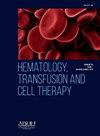RISK OF DEVELOPING ONCOHEMATOLOGICAL DISEASES IN INDIVIDUALS INFECTED WITH HEPATITIS C AND B VIRUS
IF 1.6
Q3 HEMATOLOGY
引用次数: 0
Abstract
Objective
There are data in the literature on the possible etiologic role of Hepatitis C Virus (HCV) in the development of some hematological malignancies. However, these studies were heterogeneous, for example, the control groups varied from blood donors to patients with other hematological malignancies and healthy individuals. In addition, most studies included a relatively small number of patients, which did not allow for unambiguous conclusions. Based on the above, the aim of this study was to identify a possible association between hepatitis B, C and hematological malignancies.
Methodology
797 patients of the National Center of Hematology and Transfusiology with various forms of malignant blood diseases and positive Hepatitis B (HbAgS) and C (anti-НСV) markers at the time of the diagnosis were analyzed. As a control group were used positive hepatitis B and C blood donors from the Central Blood Bank. The association between malignant blood diseases and infectious hepatitis was estimated using the Relative Risk (RR) and Odds Ratio (OR) with a 95% Confidence Interval. Differences were considered significant at p < 0.05. Statistical analysis was performed using SPSS software.
Results
The study revealed a positive association between a positive anti-HCV status and the risk of developing Non-Hodgkin Lymphoma (NHL) (RR/OR = 11.7/13.3, p = 0), Acute Lymphoblastic Leukemia (ALL) (RR/OR = 6.76/7.22, p = 0), Chronic Lymphoid Leukemia (CLL) (RR/OR = 5.9/6.24, p = 0), Multiple Myeloma (MM) (RR/OR = 3.94/4.08, p = 0.008752) and Acute Myeloid Leukemia (AML) (RR/OR = 4.7/4.91, p = 0.000001). In cases of Myeloproliferative Neoplasms (MPN), a statistically significant association could not be determined. Hepatitis B was statistically significantly associated with NHL (RR/OR = 5.27/5.56, p = 0.000465), CLL (RR/OR = 5.31/5.61, p = 0.000001), MM (RR/OR = 5.31/5.61, p = 0.000001) and MPN (RR/OR = 4.3/4.48, p = 0.000570).
Conclusion
Thus, it can be concluded that hepatitis C and B viruses may play a role in the development of some hematological malignancies, such as leukemia and lymphoma. HBV can contribute to the development of hematological malignancies by changing cell proliferation and causing chronic inflammation, which can disrupt the normal functioning of the immune system. Also, chronic inflammation activates cytokines and growth factors that can increase the risk of cell mutation, which in turn leads to the development of malignant tumors.
丙型肝炎和乙型肝炎病毒感染者发生血液肿瘤疾病的风险
目的研究丙型肝炎病毒(HCV)在某些血液系统恶性肿瘤中可能的病因学作用。然而,这些研究是异质的,例如,对照组从献血者到患有其他血液恶性肿瘤的患者和健康个体各不相同。此外,大多数研究纳入的患者数量相对较少,因此无法得出明确的结论。基于以上,本研究的目的是确定乙型肝炎、丙型肝炎和血液恶性肿瘤之间可能存在的联系。方法对国家血液学输血中心797例诊断时患有各种形式恶性血液病和乙型肝炎(HbAgS)和丙型肝炎(抗-НСV)标志物阳性的患者进行分析。作为对照组的是来自中央血库的乙肝和丙肝阳性献血者。恶性血液病与传染性肝炎之间的关联采用相对危险度(RR)和优势比(OR),置信区间为95%。p <的差异被认为是显著的;0.05. 采用SPSS软件进行统计分析。ResultsThe研究揭示积极联系积极anti-HCV地位和发展非霍奇金淋巴瘤(NHL)的风险(RR /或 = 11.7/13.3,p = 0),急性淋巴细胞白血病(ALL) (RR /或 = 6.76/7.22,p = 0),慢性淋巴白血病(CLL) (RR /或 = 5.9/6.24,p = 0),多发性骨髓瘤(MM) (RR /或 = 3.94/4.08,p = 0.008752)和急性髓系白血病(AML) (RR /或 = 4.7/4.91,p = 0.000001)。在骨髓增生性肿瘤(MPN)的病例中,统计上的显著相关性无法确定。乙型肝炎相关有统计学显著NHL (RR /或 = 5.27/5.56,p = 0.000465),慢性淋巴细胞白血病(RR /或 = 5.31/5.61,p = 0.000001),MM (RR /或 = 5.31/5.61,p = 0.000001)和或然数(RR /或 = 4.3/4.48,p = 0.000570)。结论丙型肝炎病毒和乙型肝炎病毒可能在某些血液系统恶性肿瘤如白血病和淋巴瘤的发生发展中起作用。HBV可以通过改变细胞增殖和引起慢性炎症来促进血液系统恶性肿瘤的发展,这可以破坏免疫系统的正常功能。此外,慢性炎症会激活细胞因子和生长因子,从而增加细胞突变的风险,从而导致恶性肿瘤的发展。
本文章由计算机程序翻译,如有差异,请以英文原文为准。
求助全文
约1分钟内获得全文
求助全文
来源期刊

Hematology, Transfusion and Cell Therapy
Multiple-
CiteScore
2.40
自引率
4.80%
发文量
1419
审稿时长
30 weeks
 求助内容:
求助内容: 应助结果提醒方式:
应助结果提醒方式:


